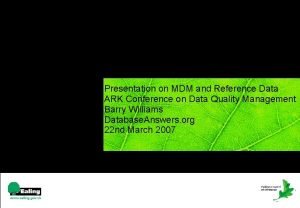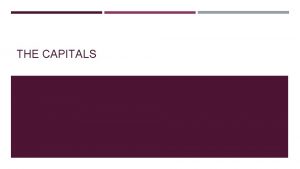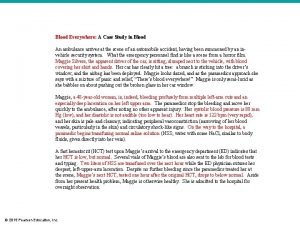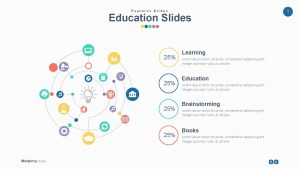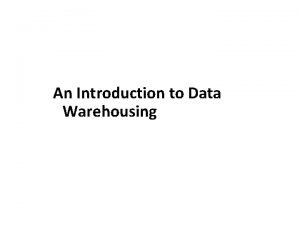Chapter 1 Data Everywhere Data Everywhere All slides



















- Slides: 19

Chapter 1 Data Everywhere

Data Everywhere All slides in this presentations are based on the book Functions, Data and Models, S. P. Gordon and F. S Gordon ISBN 978 -0 -88385 -767 -0 • We are surrounded in everyday life by different data. Here are some important questions regarding data. 1. How to make decisions based on data? 2. How to interpret data? 3. How to use data to answer various questions? • One variable data; two-variable data; data on more than 2 variables p. 2

Two-Variable Data Independent/Dependent Variables Scale

Two Variable Examples In many situations we have data that involve 2 different quantities/variables a) Education level and salary of employees b) Height and weight of people c) Size of a land/habitat and number of distinct species who live there p. 4

Example of Two Variable Data Ex. Number of reptiles and amphibians living on different islands in the Caribbean Sea and the area of these islands in sq. miles • Two variables – lets give them names N - number of species A - area • One of them depends on the other… What do you suggest? p. 5

Independent/Dependent Variables • We have two quantities/variables; • one depends on the other One is the independent variable, the other is the dependent variable • Which is the independent variable? How about the dependent variable? Why? p. 6

Independent/Dependent Variables • N (number of species) is the dependent variable and A (area of the island) is the independent variable • The independent variable is graphed horizontally and the dependent variable - vertically p. 7

Graphing the data - Scale The area A extends horizontally from 1 to 44, 218 sq. miles The number of species N extends vertically from 3 to 84 1. From 0 to 45, 000 sq. miles with tick marks every 15, 000 sq. miles 1. From 0 to 90 with tick marks every 10 species 2. From 0 to 45, 000 sq. miles with tick marks every 9, 000 sq. miles 2. From 0 to 100 with tick marks every 20 species 3. From 0 to 50, 000 sq. miles with tick marks every 5, 000 sq. miles 3. From 0 to 100 with tick marks every 10 species p. 8

Scatter Plots Def - a graph in which the values of two variables are plotted along two axes, the pattern of the resulting points revealing any correlation present. • Island “Saba” is represented by the point (A, N) = (4, 5) • Jamaica – by (A, N) = (4 411, 39) • Cuba – by (A, N) = (44 218, 76) p. 9

Scatter Plots - Example Continued • As the Area of the island increases, the Number of species who live on the island also increases • • N grows more and more slowly as A increases Want to answer predictive questions, e. g. Area of Barbados is 166 sq. miles; estimate the number of species that live there Estimate the size of a habitat that will support 25 species of reptiles and amphibians p. 10

US population between 1780 and 1900 • Which is the independent/dependent variable? • What scale of the scatter is good to be used? • State what each variable you use stands for in reality • • Draw the scatterplot What predictive questions can be answered later once we get a formula? p. 11

Scatterplot of US population since 1780 p. 12

Predictive Questions • What would the population of the U. S. have been in 1920? • What was the population in 1875? • When would the U. S. population have reached 100 million? p. 13

Independent/Dependent Variable Examples • In a study to determine whether how long a student sleeps affects test scores; what is the independent variable and what is the dependent variable? • The independent variable is the length of time spent sleeping while the dependent variable is the test score. p. 14

Independent/Dependent Variable Examples • If you want to know whether caffeine affects your appetite, what is the independent variable and what is the dependent variable? • the presence/absence of the amount of caffeine would be the independent variable. How hungry you are would be the dependent variable. p. 15

Independent/Dependent Variable Examples • You want to compare different brands of paper towels, to see which holds the most liquid. What is the independent variable and what is the dependent variable? • The independent variable in your experiment would be the brand of paper towel. The dependent variable would be the amount of liquid absorbed by a paper towel. p. 16

Example Temperature readings were recorded every two hours from midnight to 2: 00 P. M. in Dallas on June 5, 2017. The time was measured in hours from midnight. time Temperature 0 73 2 73 4 70 6 69 8 72 10 81 12 88 14 91 a. Decide which is the independent variable and which is the dependent variable. b. Decide on the appropriate scales for the two variables for a scatterplot. c. What letter will you use for each variable? d. Draw the scatterplot. p. 17

Solution Temperature readings were recorded every two hours from midnight to 2: 00 P. M. in Dallas on June 5, 2017. The time was measured in hours from midnight. time Temperature 0 73 2 73 4 70 6 69 8 72 10 81 12 88 14 91 a. Decide which is the independent variable and which is the dependent variable. The Independent variable is time and the dependent variable is Temperature b. Decide on the appropriate scales for the two variables for a scatterplot. The time scale: 0 – 16 increments of 2 and the Temperature scale: 65 – 95 increments of 5 c. What letter will you use for each variable? We might use t for time and T for Temperature. d. Draw the scatterplot. (next page) p. 18

Solution Dallas Weather 95 90 Temperature 85 80 75 70 65 0 2 4 6 8 time 10 12 14 16 p. 19
 Everywhere you go everywhere you look
Everywhere you go everywhere you look A small child slides down the four frictionless slides
A small child slides down the four frictionless slides Change in energy quick check
Change in energy quick check Data data everywhere and not a thought to think
Data data everywhere and not a thought to think Name a point that is collinear with the given points
Name a point that is collinear with the given points Class 8 english chapter 7 water water everywhere
Class 8 english chapter 7 water water everywhere Data mining slides
Data mining slides Reference data conference
Reference data conference Data mining concepts and techniques slides
Data mining concepts and techniques slides Data mining confluence of multiple disciplines
Data mining confluence of multiple disciplines Data driven powerpoint
Data driven powerpoint I've been everywhere canada
I've been everywhere canada The great tao
The great tao Security that fits everywhere
Security that fits everywhere Linux everywhere
Linux everywhere It's just everywhere uk feminista
It's just everywhere uk feminista Characteristics of infatuation
Characteristics of infatuation 3 formed elements in blood
3 formed elements in blood Every learner everywhere
Every learner everywhere Favorite motto
Favorite motto







